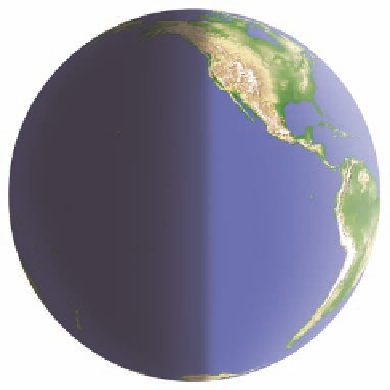Geoscience Reference
In-Depth Information
The Seasons
North Pole
Sun angle, 0
°
Sun's rays
To understand how the Earth's axial tilt causes the seasons, first
imagine what would happen if the Earth's axis were
not
tilted
(Figure 3.9). Under these circumstances, as Earth traveled around
the Sun on the plane of the ecliptic, the Sun's rays would always
strike Earth most directly at the Equator. As a result, the subso-
lar point would perpetually be at the Equator and the Sun's rays
would always strike Earth at progressively lower angles with in-
creasingly higher latitudes (greater than 0°). In this scenario, as
Earth revolves around the Sun, all places on Earth would receive
a consistent intensity of solar radiation (although this amount
would differ with latitude) over the course of the year and dis-
tinct seasons would not be experienced anywhere on the planet.
Now picture the Earth's actual axial tilt, which is 23.5° from
a line perpendicular to the plane of the ecliptic. Keep in mind
that the axis maintains a constant tilt angle
and
orientation as
Earth travels around the Sun (Figure 3.10). These geometric re-
lationships—angle and orientation—are the fundamental cause
of our seasons because one of the hemispheres is always in the
gradual process of tilting more toward the Sun while the orbit
progresses, whereas the other one is slowly tilting away from the
Sun. You might be thinking, “Wait a minute, you just said that the
axial tilt and orientation never change; isn't that contradictory?”
To see why not, examine Figure 3.10 and focus on the Northern
Hemisphere. Notice that during June, the Northern Hemisphere
is tilted
toward
the Sun, whereas in December, it is titled
away
.
The opposite is true for the Southern Hemisphere. In both cases
the tilt did not change, nor did the orientation of the tilt. Instead,
the position of Earth relative to the Sun changed as its orbit pro-
gressed
, which has the effect of moving each hemisphere either
toward or away from the Sun's rays. This apparent movement of
the hemispheres toward or away from the Sun is the fundamental
50
°
N
Sun angle, 40
°
Night
Day
Sun angle, 90
°
0
°
(Equator)
Subsolar point
30
°
S
Circle of
illumination
Sun angle, 60
°
South Pole
Figure 3.9 Geometric relationship if the Earth's axis were
perpendicular to the plane of the ecliptic.
If these condi-
tions existed, the subsolar point would always be located at
the Equator and the circle of illumination would extend from
the North to South Poles. At 50° N the Sun angle would be 40°,
whereas it would be 0° at 90° N (the North Pole).
Figure 3.9 Geometric relationship if the Earth's axis were
perpendicular to the plane of the ecliptic.
If these condi-
tions existed, the subsolar point would always be located at
the Equator and the circle of illumination would extend from
the North to South Poles. At 50° N the Sun angle would be 40°,
whereas it would be 0° at 90° N (the North Pole).
cause of the seasons because it results in the migration of the sub-
solar point 23.5° N or S of the Equator over the course of the year.
Solstice and Equinox
If you live in the Northern Hemisphere, you probably know that
the recognized first day of summer is sometime toward the end
of June. Conversely, in the Southern Hemisphere, the first day
of summer is toward the end of December. You also probably
Arctic Circle
Tropic of
Cancer
Arctic Circle
Equator
Subsolar point
Tropic of
Cancer
SUN'S
RAYS
Tropic of
Capricorn
Subsolar point
Equator
Antarctic Circle
Tropic of
Capricorn
Antarctic Circle
Winter Solstice (December21)
Summer Solstice (June 21)
Figure 3.10 Axial geometry of Earth during June and December.
Note that the axis is tilted at 23.5°, which causes the orientation
of the hemispheres to change with respect to the location of the subsolar point. On December 21, the subsolar point is at the Tropic
of Capricorn, whereas it is at the Tropic of Cancer on June 21.






















































